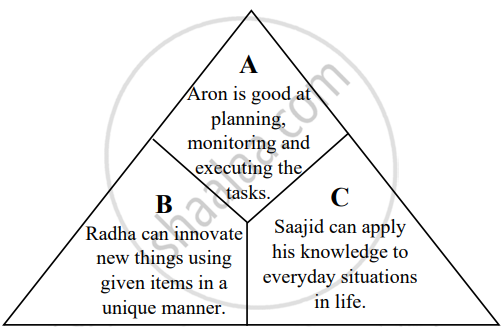Advertisements
Advertisements
प्रश्न
Sheetal aims to become a Forest Range Officer as she enjoys being amongst wildlife and wants to protect them from any harm.
- Identify the type of intelligence that Sheetal possesses. Which theory of Intelligence is being indicated here? (2)
- According to the above theory of Intelligence, enumerate any two types of intelligence other than the one referred to above and any two corresponding professions. (2)
उत्तर
- Sheetal possesses Naturalistic intelligence.
Howard Gardner’s theory of Multiple Intelligence is indicated here. - Types of Intelligence
- Verbal skills: The ability to think in words and to use language to express meaning.
Corresponding professions: Authors, Journalists, Speakers. - Mathematical/Logical skills: The ability to carry out mathematical operations.
Corresponding professions: Scientists, Engineers and Accountants. - Spatial skills: The ability to think 3-dimensionally.
Corresponding professions: Architects, Artists, Sailors. - Bodily-kinesthetic skills: The ability to manipulate objects and be physically adept.
Corresponding professions: Surgeons, craftspeople, dancers, athletes. - Musical skills: sensitivity to pitch, melody, rhythm and tone.
Corresponding professions: Composers and musicians. - Interpersonal skills: The ability to understand and interact effectively with others.
Corresponding professions Teachers, mental health professionals. - Intrapersonal skills: The ability to understand oneself.
Corresponding professions Theologians and Psychologists.
- Verbal skills: The ability to think in words and to use language to express meaning.
APPEARS IN
संबंधित प्रश्न
In Jensen’s model, Level II represents ______.
Two statements are given in the question below as Assertion (A) and Reasoning (R).
Assertion (A): PASS processes operate on a knowledge base developed either formally (through reading and writing and experimenting) or informally from the environment.
Reason (R): The functioning of these processes are not interdependent on each other.
Read the case given below and answer the questions by choosing the most appropriate option:
This is a story of three students Ruby, Radhika and Shankar who were enrolled in an Undergraduate Psychology Program in a University. Ruby was the admission officer’s dream. She was selected for the program as she had perfect entrance test scores, outstanding grades and excellent letters of recommendation. But when it was time for Ruby to start coming up with ideas of her own, she disappointed her professors.
On the other hand, Radhika did not meet the admission officer’s expectations. She had good grades but low entrance exam scores. However, her letters of recommendation described her as a creative young woman. She could design and implement research work with minimal guidance at college.
Shankar ranked somewhere in between the two students. He was satisfactory on almost every traditional measure of success. But rather than falling somewhere in the middle of his class at college, Shankar proved to be an outstanding student. His strength lay in the ability to not only adapt well to the demands of his new environment but also to modify the environment to suit his needs.
Identify the three components of intelligence that Ruby is high on.
The proponent of the Cognitive Theory of teaching is-
The first experiment to measure the span of attention (apprehension) was designed by ______
Read the case study and answer the question that follows:
| When Srikanth Bolla was born, neighbours in the village suggested that his parents smother him. It was better than the pain they would have to go through their lifetime, some said. He is a “useless” baby without eyes; being born blind is a sin, others added. Twenty-three years later, Srikanth is standing tall living by his conviction that if the “world looks at me and says, Srikanth, you can do nothing, I look back at the world and say, I can do anything.” Srikanth is the Founder and CEO of Hyderabad-based Bollant Industries, an organisation that employs uneducated and challenged employees to manufacture eco-friendly, disposable consumer packaging solutions, which is worth ₹ 50 crore. He considers himself the luckiest man alive, not because he is now a millionaire but because his uneducated parents, who earned ₹ 20,000 a year, did not heed any of the ‘advice’ they received and raised him with love and affection. “They are the richest people I know,” says Srikanth. |
We can see that Srikanth has the ability to adopt, shape and select the environment. Identify the theory of intelligence that would best support our understanding of Srikanth's intelligence.
Read the case and answer the questions that follow.
|
'My story about work-related stress' Looking back on my life, I recognize that I have always struggled with anxiety. In relationships, friendships or at work. |
Manisha was walking on the street when she sensed that she was being followed. She became alert to her environment and quickly joined the procession that was passing by.
Which one of the following types of intelligence did Manisha display?
Which psychologist proposed the Theory of Multiple Intelligence?

- By referring to Sternberg’s theory, identify the components of intelligence displayed by A, B, and C in the figure given above. (3)
- Elaborate on any two characteristics each of A and C. (4)
